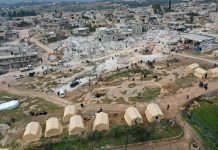Turkish Environment and Urbanization Minister Murat Kurum has said Turkey will demolish buildings severely damaged by last week’s major earthquake and quickly start reconstruction.
“We will quickly demolish what needs to be demolished and build safe houses,” Kurum tweeted.
Hasar tespit çalışmalarımız deprem bölgesinde 7.100 personelle sürüyor.
387.346 bina incelendi.
Şu ana kadarki tespitlerimize göre
ACİL YIKILMASI gereken 50.576 bina var.
279.655 bina AZ HASARLI veya HASARSIZ.
Acil yıkılması gerekenleri hızla yıkıp güvenli konutlar yapacağız! pic.twitter.com/NHJAbP9n4I— Murat KURUM (@murat_kurum) February 15, 2023
The 7.8-magnitude earthquake, which claimed the lives of over 41,000 people and injured more than 80,000 across in Turkey and Syria, was followed by dozens of aftershocks, including a 7.5-magnitude temblor that struck the region later the same day.
The Turkish government encouraged people to go back home, if and when the authorities deem their buildings safe, “in order to start getting back to normal,” Tourism Minister Nuri Ersoy told a news conference in Malatya, some 160 kilometers from the epicenter of the earthquake, Reuters reported.
According to the Turkish Chamber of Civil Engineers (İMO), poor soil conditions, the use of substandard materials and the lack of effective inspections were among the main reasons the earthquakes caused so much destruction in southeastern Turkey.
The chamber, affiliated with the Turkish Union of Engineers and Architects Chambers (TMMOB), on Tuesday released a preliminary report on the 7.8-magnitude quake that struck near the city of Gaziantep as people slept on February 6.
Many buildings that were built after 2000 collapsed or were heavily damaged in the major quakes because they were constructed on farmland, in soil with the potential of liquefaction or in areas with the bedrock buried deep below the surface, the report said.
The chamber listed other causes of the massive destruction as the absence of infill walling on the ground floors of buildings and the lack of efficient inspections, thus preventing the detection of structures that aren’t earthquake-resistant.















